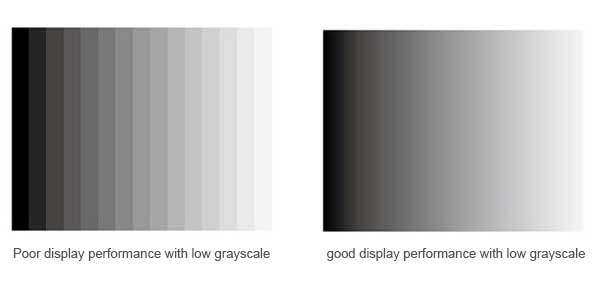Glossary of Graryscale of LED Display
How to Control the Grayscale of LED Displays
The grayscale of LED displays can also be called as the luminance of LED displays. The grade of grayscale is also called the half-tone, being mainly used to transmit pictures through their grades, namely Grade 16, Grade 32 and Grade 64. It uses the matrix to process the pixels of files into Grade 16, Grade 32 and Grade 64 to make pictures clearer. No matter it is a monochrome, bi-color or tri-color display, every luminous grayscale that constitutes pixels should be adjusted to suggest pictures or motion pictures. The accuracy level of the adjustment is the grade of grayscale.

The brightness discrimination level refers to the brightness level between the darkest and whitest of images that can be distinguished by humans. As mentioned above, the grade of grayscale of some displays may be very high, such as Grade 256 or even Grade 1024. But due to the limited sensitivity to brightness, these grades of grayscale cannot be fully recognized by human eyes. That is to say, it is possible that grayscales with close grades may be the same in human eyes. Moreover, the discrimination ability of eyes varies from person to person. It is good for humans to recognize as many grades of grayscales as they can, for displays are made for humans to watch. The more brightness levels humans can distinguish, the bigger the color space for displays, the greater its potential to suggest colors. The brightness discrimination level can be tested by special software. Generally, good displays can reach above Grade 20.
The nonlinear transformation of grayscale refers to transforming the grayscale data according to experience data or some arithmetic nonlinear relations, and then provide it to displays. LED is a linear device. It has different nonlinear display characteristics from traditional displays. To make sure that the LED display effect to conform to the traditional data source without losing the grayscale, the nonlinear transformation of the data of grayscale will generally be performed inside LED display systems. Data bits will be increased after the transformation (to ensure that the data of grayscale are not lost).
There are two ways to control the grayscale of LED displays: to change the current flowing through and to modulate the pulse width. 1. Change the current flowing through LED. Generally, the continuous working current of LED is around 20mA. Except for the saturation of red LEDs, grayscales of other LEDs are basically proportional to the current flowing through. The other method is to take advantage of visual inertia of human eyes, by controlling the grayscale by modulating the pulse width. It can change the optical pulse width periodically. As long as the period of lighting repeatedly is short enough, human eyes cannot feel the luminous pixels vibrating.
Since the digital control is more suitable to the pulse width modulation, almost all LED displays use pulse width modulation to control the grade of grayscale when microcomputers are widely used today to provide the content for displays.
The grayscale and brightness of displays are important parameters for LED products. To better use LED displays, it is necessary to understand the relationship between the grayscale and brightness of LED displays.